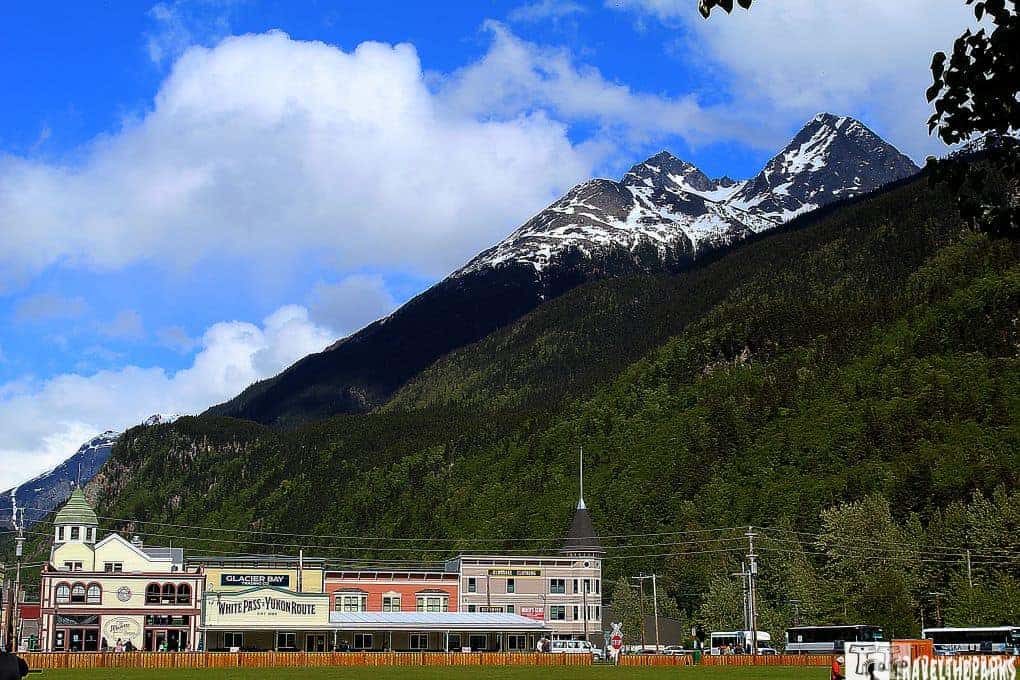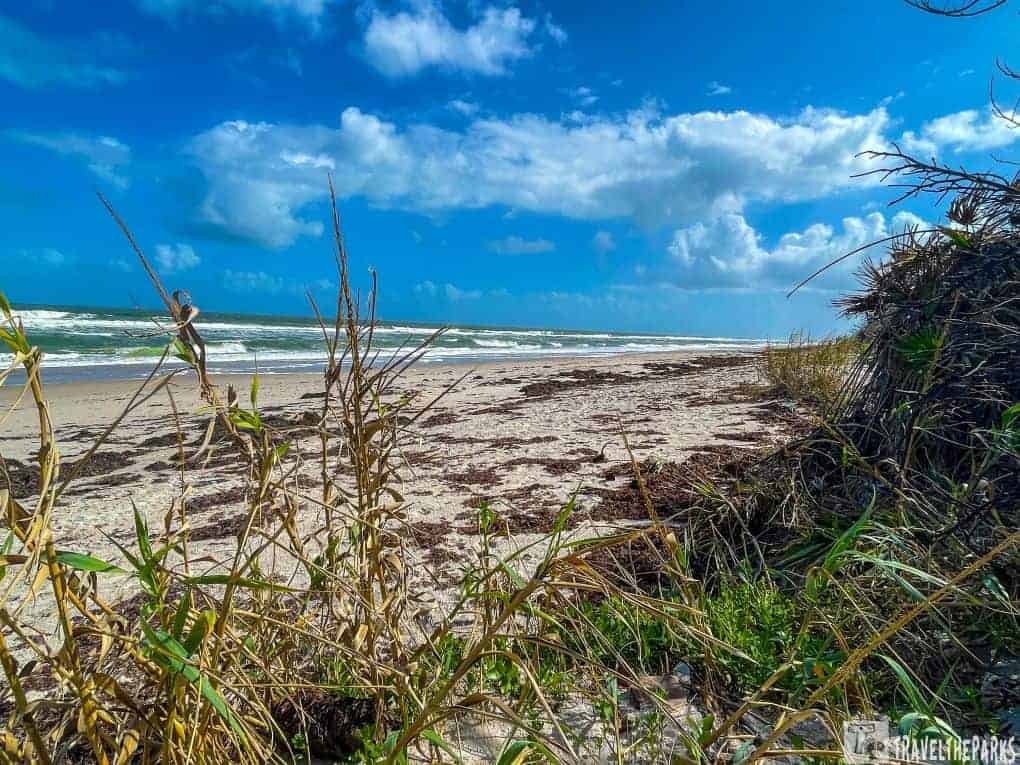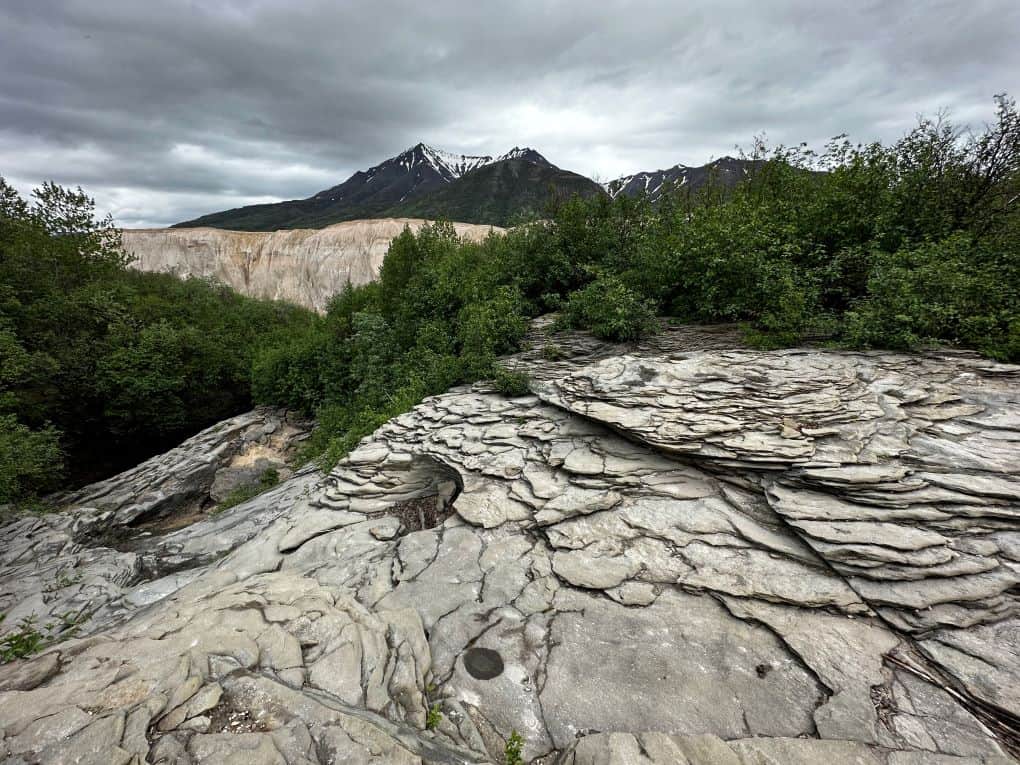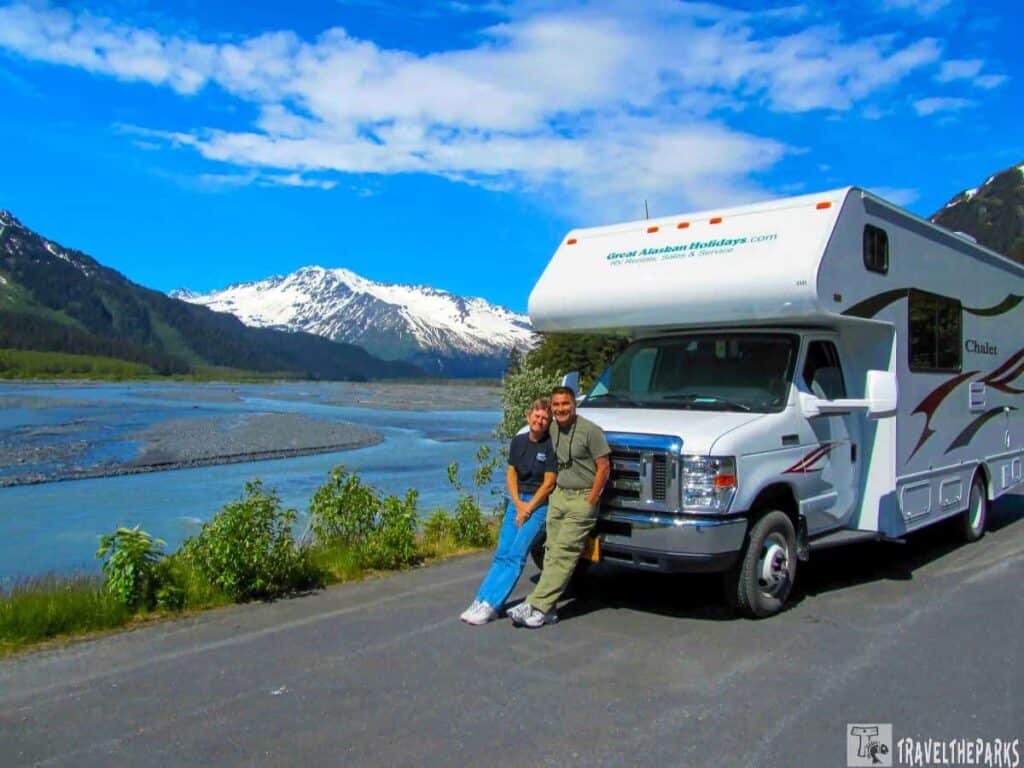Skagway still preserves much of its frontier spirit. This town is the vibrant heart of the Klondike region. Wandering along the wooden boardwalk sidewalks, we discovered the history of this quaint little town. It’s a scene that seems straight out of a postcard. There are endless opportunities to explore the past in Skagway while gaining a deeper appreciation of this iconic destination.

This post may contain affiliate links, meaning if you purchase something through one of these links, we may earn a small commission at no extra cost to you! Read the full disclosure policy here.
Table of Contents
Morning Adventures: White Pass & Yukon Route Railroad
This morning our ship Nieuw Amsterdam, quietly docked while we were sleeping. This morning, my companion was not feeling well. Despite the unexpected change of plans, I am excited to embark on this solo journey to discover the wonders that Skagway offers. Once I’ve grabbed a quick breakfast, I check on my husband before heading to the gangway. Today, since there has been a recent landslide, the ship must use tender boats to transport passengers to the small boat harbor. Moving through the crystal clear waters hemmed in by snow-covered mountains, I am excited about my next adventure.
Riding the Rails of the Historic White Pass & Yukon Route Railroad
When I was 9, I remember reading “Call of the Wild.” It captured my imagination. I believed that a ride on the White Pass & Yukon Route Railroad could somehow make the tales of the Klondike Gold Rush come to life.
Meeting the train dockside, I find my seat in the last train car. I’ve been told the best views are on the left side going up to the summit. I take the last seat at the back of the train car. This gives me a good view and easy access to the outside viewing platform. This train climbs to summit an elevation of 2888 feet. At the top of White Pass, where just across the Canadian border, the train makes a loop before heading back to Skagway.

I have always loved how a train sways gently back and forth. It almost puts you to sleep. Today it is quite comforting. As the train chugs along, it builds momentum as it climbs higher into the rugged mountain pass. I stood at the railing, treated to sweeping vistas of snow-capped peaks. One thing I noticed was that you would hear the cascading waterfalls well before the train actually passed them. The rhythmic chugging and whistle blasts only seem to add to my sense of adventure I feel as we traverse sturdy trestles and hidden tunnels. Passing Bridal Veil Falls, Inspiration Point, Dead Horse Gulch and the Klondike Trail of ‘98, just to name a few.

A Treacherous Journey to Riches
This train follows the same route as the 1898 Klondike stampeders. The narration provided by our guide perfectly blends the past and the present. Her words paint a vivid picture, delving into a bygone era. Uncovering the stories of the Klondike gold rush, she filled each tale with fascinating anecdotes and historical facts. You have t admire the indomitable spirit of those who braved the harsh Alaskan wilderness. The challenges they faced mirrors the intriguing storytelling I found in the pages of my Jack London novel.

Through her narratives, we learned the railway was constructed between 1898 and 1900. It provided transportation for miners seeking their fortunes in the Yukon Territory. Another tidbit of how Dead Horse Gulch got its name. The Chilkoot Trail and the White Pass Trail were the main routes to the Yukon Goldfields. Many of the Klondike prospectors chose the White Pass Trail, using horses to transport an enormous amount of equipment. Many of the pack animals were overburdened and mistreated. It is said that the treacherous conditions were responsible for the deaths of 3,000 horses.

y Klondike Gold Rush History: Reaching the Summit White Pass
After a few hours, the train reached the summit of White Pass; the air growing quite crisp. Here, the landscape undergoes a dramatic transformation.During the early spring, the top of Whites Pass still held the icy grip of winter, surprising me. The frozen lakes with their icy blue pools made it feel like stepping into a frozen fairy tale. Much of the top is tundra, devoid of the lush forest we saw closer to Skagway.

I have to say, hopping aboard the White Pass & Yukon Route Railroad was an absolute blast! It easily ranks as one of the most unforgettable adventures I’ve had during my visits to Alaska. The journey took me on a trip to a time of gold fever when there was a spirit of exploration. A must do for anyone visiting Skagway.

Here are a few more ideas for organizing your trip:
- I recommend securing your tickets early, as the busiest times are fast-selling.
- Seek out a spot on the left side of the train, near the rail exit for a better outside view.
- Wear clothing in multiple layers, as mountain weather is often unpredictable.
- Make sure your phone or camera is charged and ready to snap the wide-angle shots. This excursion includes a complimentary bottled water.

Afternoon Delights: The Klondike Gold Rush National Historic Park
I kick off my afternoon adventure by exploring the historic downtown area. This town still evokes a feeling of the late 1800s, with its many colorful storefronts, wooden boardwalks, and dusty streets. The National Park Service has multiple locations in Skagway. My first stop was the Klondike Gold Rush National Historical Park Visitor Center (1898) at the corner of Broadway and 2nd Street. Until the 1960s, this building served as the towns train depot. Inside, it has been restored to its original appearance. I spent 30-minutes looking through the exhibits, learning more about the history of the gold rush. Open daily during the summer months. This is a great place to start an exploration of the town and get your passport stamps.

The heavily burdened gold rush stampeder put on the most captivating display. It seems that to prevent a food shortage, the Canadian government mandated that everyone must carry a sufficient amount of supplies. These supplies encompassed food, attire, and other essential things needed to support themselves and their families. Travelers to the Yukon goldfields were not allowed to proceed if they did not have these necessary supplies.

Skagway Klondike Gold Rush history
There are a combination of other museums and buildings that comprise the Klondike Gold Rush National Historical Park, managed by the National Park Service.

Exploring historic Skagway Alaska: Mascot Saloon Museum (1898)
Easy to find at 3rd and Broadway is open daily from 9am till 5pm. The inside recreates the ambiance of a typical gold rush-era saloon. It served as a bar, gambling hall, and social hub for miners, prospectors, and other travelers.

Exploring historic Skagway Alaska: Jeff Smith’s Parlor Museum (1897)
The museum is on 2nd between Broadway and State Street. They are open on weekends from 9am to 5pm. During the week, the NPS offers 30 minute ranger-guided tours. It highlights the activities of Jefferson Randolph “Soapy” Smith, an infamous con artist and gangster. Arriving in 1897, he quickly took control of the town’s criminal underworld. His gang ran various cons. He tried to maintain a facade of respectability through involvement in local civic activities and charity work.

Exploring historic Skagway Alaska: Pantheon Saloon (1897)
Found at the corner of Broadway and 4th, is the Junior Ranger Activity Center. It is open weekdays from 10am to 3pm. Park Ranger can assist kids in completing the activity book to earn their Junior Ranger Badge.

Exploring historic Skagway Alaska: Trail Center-Boss Bakery (1897)
In the center of town on Broadway, it has exhibits about the Chilkoot Trail. It was the primary route to the Klondike. Watch the film on the trail to Lake Bennett makes you feel you are actually hiking it. The rangers at the information center are extremely helpful in giving preparation tips for any hikers venturing onto the trail.

Exploring historic Skagway Alaska: Arctic Brotherhood Hall (1900)
The unique architecture of this building is truly impressive. Built in 1899, it served as the community meeting place for the Arctic Brotherhood, a fraternal organization established in 1899. What is most interesting is the thousands of pieces of driftwood that decorate the outside facade. It too is listed on the National Register of Historic Places. During the Gold Rush era, it was referred to as Camp Skagway No. 1.

Exploring historic Skagway Alaska: Martin Itjen House Bookstore (1901)
Located on Broadway between 1st and 2nd Avenue, this building was constructed by David J. Rich in 1901. Rich and his wife resided in the small cottage until 1920. The first business owners in Skagway, Itjen and his wife Lucy, were quick to see the potential in tourism. They ran various businesses such as a streetcar, boarding houses, and confectioneries until their passing in the 1940s. The wooden cottage has been moved several times before being acquired by the NPS. After being renovated in 1991, it now serves as the NPS bookstore.
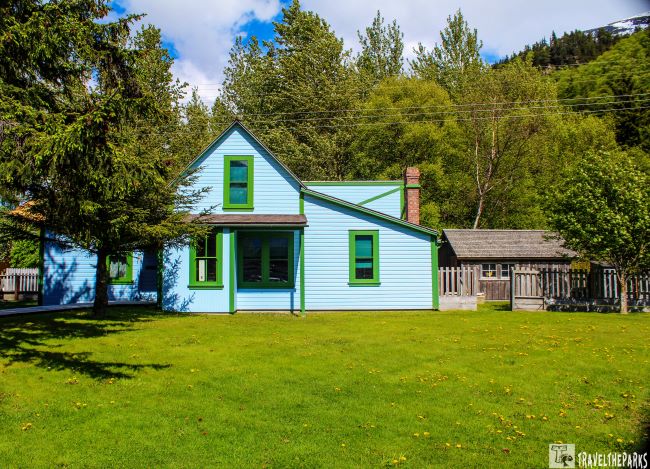
Skagway Historical Attractions: Moore Homestead Museum (1897)
Turning a corner off the boardwalk, I was surprised to find a charming homestead on 5th between Broadway and Spring Street. This was by far my favorite site. Given the abundance of cruise ships docked nearby, the place was deserted. I had it all to myself. You can explore one of the oldest surviving buildings at your own pace by taking a self-guided tour. It is open from 10 a.m. to 5 p.m. every day. Today the ranger is late and opens the museum just for me to explore.

The museum tells the story of Skagway’s founding family, Captain William Moore and his son, Ben Moore. They were among the first non-native residents of the Skagway Valley. Inside are exhibit rooms set up to represent typical living spaces, such as the parlor, kitchen, and bedrooms, providing a window into the domestic life of the period. The old homestead is a symbol of why it’s crucial to protect our past and pay tribute to the people who influenced Skagway’s development.
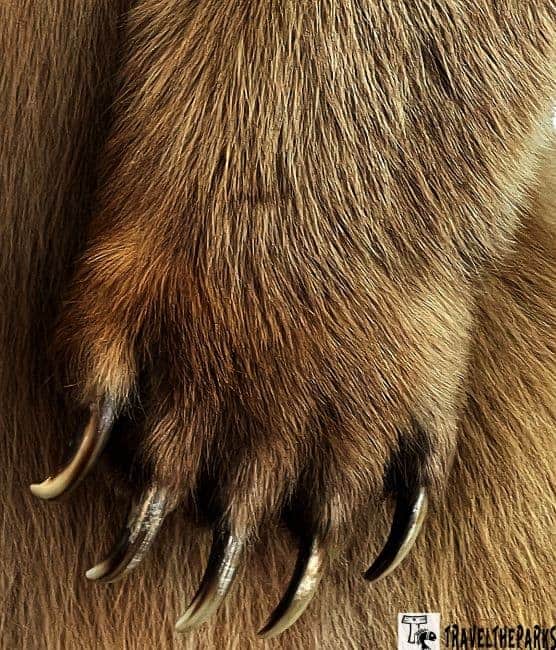
Skagway Museum and Archives (Trail of ’98 Museum)
This is a kind of hidden gem, away from the downtown hustle and bustle. I stubbled upon it by accident. The museum occupies the McCabe College building at 7th Avenue and Spring Street. Originally built in 1899 to educate the miners’ children, the building now serves as the city hall and museum. It is listed on the National Register of Historic Places. Away from the cruise ship crowds, this museum features artifacts, photographs, and displays that depict life in Skagway from the early days as a Tlingit trading post to its more tumultuous origins as a gold rush town. The oral histories gave insights into the daily lives of residents were fascinating.

I learned about the shipwreck of the SS Princess Sophia’s and its eventful journey. This was a story I had never heard before. I guess on October 23, 1918; the ship set sail from Skagway with 350 people on board. As night fell, a heavy snowstorm made it difficult to see as she steamed towards Juneau. Unfortunately, the ship collided with Vanderbilt Reef. Tragically, over a two-day period, she broke apart. Rescuers could not reach the vessel for a rescue. All was 350 souls were lost to the sea. The sole survivor, a dog named Tommy. There is also a commemorative plaque in Centennial Park detailing the disaster. This was a nice stop and I suggest if you have the time go, admission is just $2.

Things to do in historic Skagway: Visit the Gold Rush Cemetery
The Gold Rush cemetery is a fascinating place I was eager to visit. Its historical significance for me made this a must-see attraction. Located just off a gravel road on the outskirts of town, a shuttle service is available from town for a $5 fee each way. The cemetery has gained unexpected popularity, which I found surprising. I guess it is now on the radar of most of the cruise excursion tours.

A Must Do Visit in Skagway: Lower Reid Falls
The shuttle has no one else on it for both of my trips. The driver, a local, chatted about the history of the town, dropping me at the cemetery just as the tour buses are leaving.

The Story of Soapy Smith: An Infamous Klondike History
One of the most infamous figures buried here, Soapy Smith, was a gangster who ran a criminal empire in Skagway. Known for his swindles Soapy Smith’s reign in Skagway ended violently. On July 8, 1898, he was involved in a shootout with lawman Frank H. Reid. He and other town members had formed a vigilante committee to rid the town of Smith’s influence. The confrontation, known as the Shootout on Juneau Wharf, resulted in Smith’s death and Reid’s mortal wounding.

Soapy Smith is just one of the well-known figures buried here. Considered a notorious criminal, he was renown for his deceptive methods. Soapy Smith’s reign over Skagway ended tragically with a violent confrontation. On July 8, 1898, he engaged in a gunfight with Frank H. Reid, who, along with other town vigilantes. They had formed a group Committee of 101 to dismantle Smith’s influence. This clash, known as the Shootout on Juneau Wharf, resulted in Smith’s death (shot in the heart) and Reid’s fatal injury (died 12-days later).

After reading a few more of the headstones’ history, I head back to the shuttle station. Talking with the shuttle driver, he states how this cemetery serves as a reminder of the hardships faced by those who came to Skagway seeking fortune, many of whom succumbed to disease, accidents, and violence.

Things to do in historic Skagway: Yakutania Point Trail
After the cemetery, I needed some quiet time. I couldn’t decide whether to hike to Upper or Lower Dewey Lake(3-miles) or Yakutania Point. Finally, chose to hike the Yakutania Point Trail. It is a short 1.4-mile out-and-back trail. First, I crossed the footbridge over the Skagway river. Turning left, I followed a very well-maintained trail. During the walk, it meandered past rock outcroppings and Sitka spruce forests. At the end, I did have to scramble over the rocks, but it was worth it for the great panoramic views of the Lynn Canal, the cruise ships, and the port.

The Red Onion Saloon: Uncovering the Stories of the Past
This historic saloon and brothel museum has been in operation since 1898. In 1902, the Red Onion Saloon was raided by the US Marshal’s Service, and the brothels were closed down. Today, it is a fixture in Skagway drawing tourists by the thousands every year. If you watched the HBO series “Deadwood” you would recognize it. Other films and television shows have also featured the building.

Jan Wrentmore purchased the Red Onion Saloon and restored it to its former glory in 1978. The saloon is now open for visitors to buy a drink from the bar and order food. Still today the working girls still slip garters on to unsuspecting gentleman’s arms. The upstairs is a museum dedicated to the working women of Skagway. On daily tours, you can learn about the history of the brothels that once operated here.

Evening Farewell: Centennial Park Trek
Before returning to the ship, I spent time looking in the gift shops before wandering to the train depot. The train depot features a rotary snowplow used to clear the winter snows from the tracks. This rotary plow was similar to the one we had previously seen in Anchorage. If you are lucky, you can get a good photo op of the White Pass & Yukon Railway as it passes.

Inside the park is the centennial statue. Sculpted by Chuck Buchanan, it depicts a Tlingit packer leading a gold rush prospector up the trail of White Pass. Information placards paint an interesting picture. Apparently, the Tlingit never established a permanent settlement here, opting instead to use the area for hunting and fishing. They called this place shԍagéi (“Shuh-gway”), which roughly translates to “windy place” because of the constant wind coming down from the pass over the Lynn Canal. Additionally, there are benches and flower gardens here that enhance the square.

Pullen StreamWalk: A Historic Trail Along Skagway’s Waterfront
As the day begins to wind down, I make my way back to the small boat harbor, taking a detour along the Streamwalk. This park features raised boardwalks with observation platforms that allow you to view the salmon without disturbing them. Strolling along the Pullen Creek (sometimes called Dewey Creek) is an educational experience, with informational placards detailing the life cycle of salmon and their importance to the ecosystem. It is too early in the season so I see no salmon today. It is a quite shady spot that makes a loop (0.3 miles). Heading back, my legs are getting weary. Time to say goodbye to Skagway. I pass an RV park that would be ideal if we had our tent trailer. Maybe another adventure in the future.

Final Thoughts: Exploring the Past in Skagway the Heart of the Klondike
For us, Skagway was a blend of history, nature, and rugged beauty. This small Klondike town offers cruise ship visitors a unique and unforgettable experience. Cruise ship crowds often hamper much of the shopping experience, but there is a lot more to Skagway other than shopping. No matter what you decide to do in port, we are sure it will be memorable.
Have you ever been to Skagway? If so, what was the most exciting thing you did there? Share your experience in our comments!

